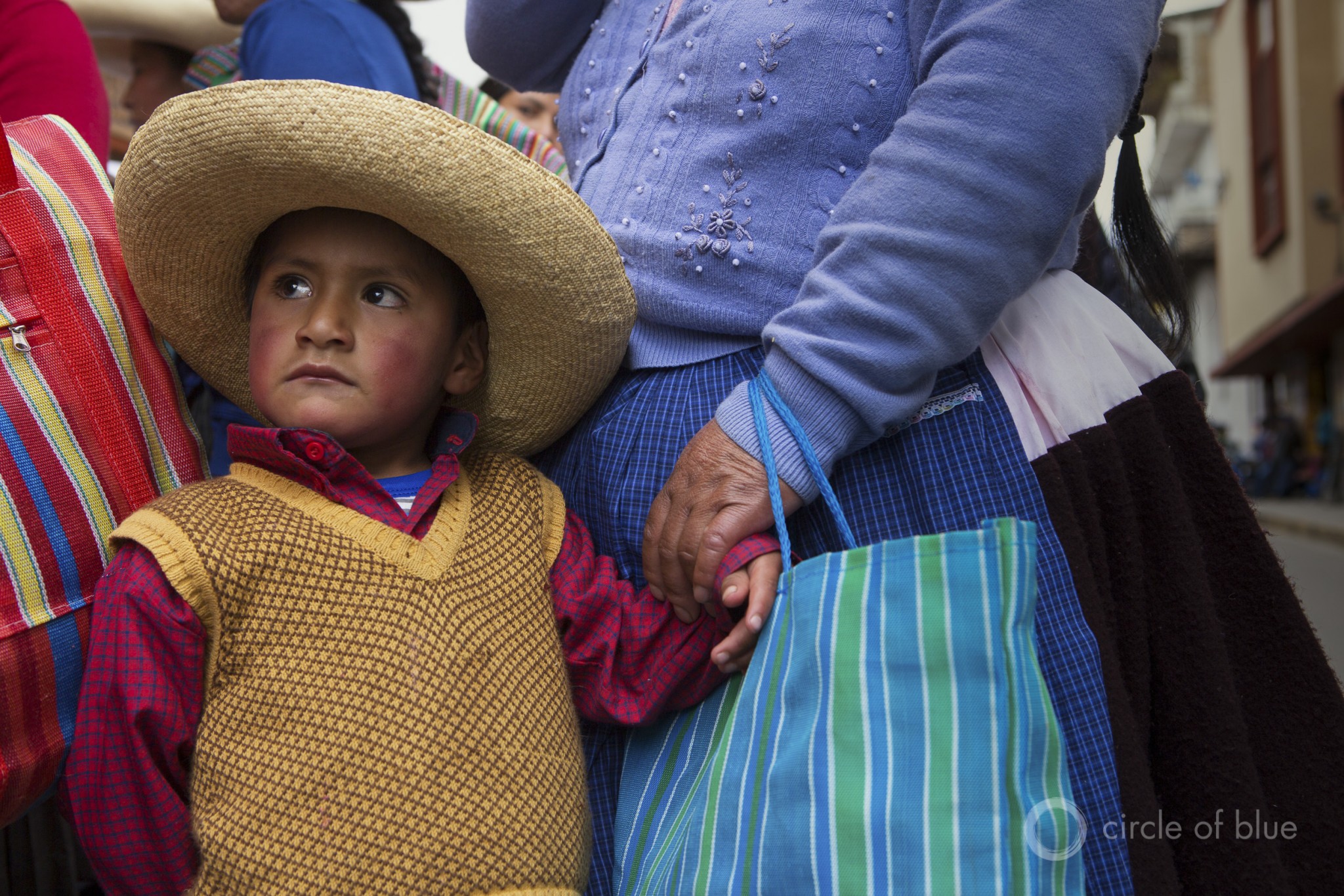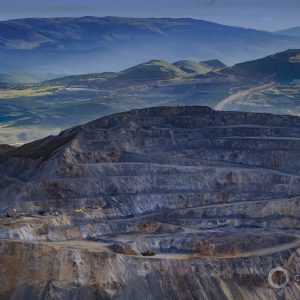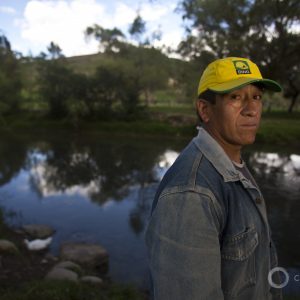Photojournal: Peru’s Water and Mining Challenge
Circle of Blue director J. Carl Ganter documents Peru’s frontline contest over water, mining, and informal settlement.

The incomparable treeless highlands of Peru’s Andes hold enormous mineral reserves and are a target of the world’s largest mining companies. Photograph @ J. Carl Ganter/CircleofBlue.org

The Andes range north of Lima also is one of the planet’s most active regions for public opposition to big open pit mines. Twenty mine projects are stalled in Peru due to low prices, water-related stress, and public opposition. Photograph @ J. Carl Ganter/CircleofBlue.org

Cajamarca, a northern Andes mountain city of 225,000, is the center of Peru’s northern mountain gold mining region. Photograph @ J. Carl Ganter/CircleofBlue.org

The colossal 23-year-old Yanacocha gold mine spans nearly 1,600 square kilometers (600 square miles) across the summits of the Andes highlands. The mine, a geography of commanding industrial persistence, also is a permanent scar on the incomparably beautiful mountain terrain. Photograph @ J. Carl Ganter/CircleofBlue.org

In 1993, when Newmont Mining Corp. and its Peruvian partner poured the first gold from the Yanacocha mine, business leaders and government officers celebrated the most significant foreign investment in Peru since the 1970s. Photograph @ J. Carl Ganter/CircleofBlue.org

The high ridges and alpine meadows of northern Peru's Andes range are among the most spectacular landscapes on Earth. The mountains also are rich in gold, copper, and other minerals that have made them targets of development for centuries. Photograph @ J. Carl Ganter/CircleofBlue.org

Since 2003, when it built a sediment control system, Newmont has approved over $100 million more in upgrades to the Yanacocha gold mine’s water collection, treatment, and discharge systems. The company has earned international recognition for its work to limit environmental damage. Photograph @ J. Carl Ganter/CircleofBlue.org

On every continent where big hard rock mineral mines, like the Yanacocha mine here, either are proposed or are operating conflict over water availability and management is raising costs, increasing risks for lenders, driving tougher government oversight, and prompting much more aggressive civic opposition campaigns. Photograph @ J. Carl Ganter/CircleofBlue.org

Water-related stress is a prominent reason that mining companies are unable to develop valuable mineral deposits around the world, in effect stranding them as undevelopable assets and sustaining billions of dollars in losses. In 2016, Newmont Mining Corp. indefinitely suspended construction of the Conga gold and copper mine near its Yanacocha mine in northern Peru. Photograph @ J. Carl Ganter/CircleofBlue.org

As evening falls beyond the Yanacocha mine, lights turn on in the campesino farms in the distance. Peru, which ranks among the world's top three producers of copper, silver, tin, and zinc, also is the seventh largest gold producer. Photograph @ J. Carl Ganter/CircleofBlue.org

This lake, and much of the highland grasslands and ridges seen from this view of the Andes, would have vanished with development of the Conga gold mine. Newmont has indefinitely suspended construction of the mine following more than a decade of protest. Photograph @ J. Carl Ganter/CircleofBlue.org

Campesinos battled to block construction of this manmade reservoir at the Conga mine. The water storage site was meant to replace four natural lakes. Photograph @ J. Carl Ganter/CircleofBlue.org

Farmers in Cajamarca fear water contamination from mines upstream from their lands. Photograph @ J. Carl Ganter/CircleofBlue.org

Campesinos demonstrated against the Conga mine in Cajamarca in June 2014. Photograph @ J. Carl Ganter/CircleofBlue.org

Andes highland farmers and their children marched in the streets of Cajamarca in opposition to the Conga gold mine. Photograph @ J. Carl Ganter/CircleofBlue.org

The terraced piles of spoils at the Yanacocha gold mine near Cajamarca are like pyramids that will mark the Andes mountain mine site for tens of thousands of years. Photograph @ J. Carl Ganter/CircleofBlue.org

Water treatment equipment at the Yanacocha mine supplies clean water to neighboring communities, and to streams and rivers. The company operates a closed loop, discharge-free system that collects, treats, and recycles the cyanide-saturated water it uses to leach gold from giant ore piles. Photograph @ J. Carl Ganter/CircleofBlue.org

When Newmont Mining Corp. suspended construction of its $5 billion Conga mine near Cajamaraca early in 2016, campesino families celebrated. The case was made that safeguarding water supplies surpassed the authority of global industrial companies to develop mega projects at will. Photograph @ J. Carl Ganter/CircleofBlue.org

After Newmont suspended operations at the Conga mine in 2011, Cajamarca slipped into recession. Idle mining equipment was stored in depots. Photograph @ J. Carl Ganter/CircleofBlue.org

A monument outside the Bureau of Energy and Mines in Lima, Peru’s capital, honors the country’s centuries-old mining economy, which stretches back 600 years to the Inca Empire. Photograph @ J. Carl Ganter/CircleofBlue.org

Water-related stress is not confined to the northern Andes. Villa El Salvador is a section of Lima, Peru’s capital, that lies between the Pacific Ocean and the coastal highlands. The community climbs up and rolls down steep slopes in a seemingly endless expanse of densely packed rooftops. Lima’s municipal government and taxpayers are not anxious to invest in infrastructure to supply running water or sanitation. As a result, Villa El Salvador residents do without. Photograph @ J. Carl Ganter/CircleofBlue.org

Water trucks dispense, at nominal or no charge, the essential resource that makes it possible for Lima's informal settlements to keep expanding. Photograph @ J. Carl Ganter/CircleofBlue.org

The unpaved streets of Villa El Salvador, lined by the one-story walls of two-room homes, have no names. Bodegas offer snacks and boxed milk at many of the street corners. Children wait patiently in the morning for school buses. Photograph @ J. Carl Ganter/CircleofBlue.org
J. Carl Ganter is co-founder and director of Circle of Blue, the internationally recognized center for original frontline reporting, research, and analysis on resource issues with a focus on the intersection between water, food, and energy.



